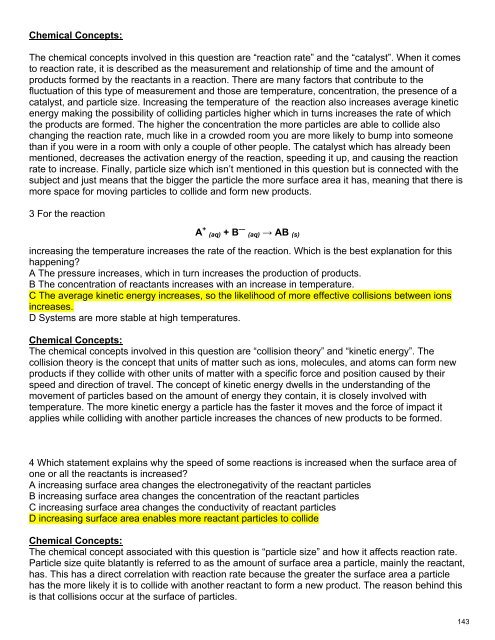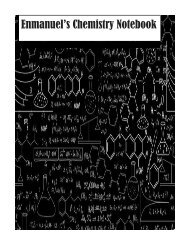You also want an ePaper? Increase the reach of your titles
YUMPU automatically turns print PDFs into web optimized ePapers that Google loves.
<strong>Chem</strong>ical Concepts:<br />
The chemical concepts involved in this question are “reaction rate” and the “catalyst”. When it comes<br />
to reaction rate, it is described as the measurement and relationship of time and the amount of<br />
products formed by the reactants in a reaction. There are many factors that contribute to the<br />
fluctuation of this type of measurement and those are temperature, concentration, the presence of a<br />
catalyst, and particle size. Increasing the temperature of the reaction also increases average kinetic<br />
energy making the possibility of colliding particles higher which in turns increases the rate of which<br />
the products are formed. The higher the concentration the more particles are able to collide also<br />
changing the reaction rate, much like in a crowded room you are more likely to bump into someone<br />
than if you were in a room with only a couple of other people. The catalyst which has already been<br />
mentioned, decreases the activation energy of the reaction, speeding it up, and causing the reaction<br />
rate to increase. Finally, particle size which isn’t mentioned in this question but is connected with the<br />
subject and just means that the bigger the particle the more surface area it has, meaning that there is<br />
more space for moving particles to collide and form new products.<br />
3 For the reaction<br />
A + (aq) + B — (aq) → AB (s)<br />
increasing the temperature increases the rate of the reaction. Which is the best explanation for this<br />
happening?<br />
A The pressure increases, which in turn increases the production of products.<br />
B The concentration of reactants increases with an increase in temperature.<br />
C The average kinetic energy increases, so the likelihood of more effective collisions between ions<br />
increases.<br />
D Systems are more stable at high temperatures.<br />
<strong>Chem</strong>ical Concepts:<br />
The chemical concepts involved in this question are “collision theory” and “kinetic energy”. The<br />
collision theory is the concept that units of matter such as ions, molecules, and atoms can form new<br />
products if they collide with other units of matter with a specific force and position caused by their<br />
speed and direction of travel. The concept of kinetic energy dwells in the understanding of the<br />
movement of particles based on the amount of energy they contain, it is closely involved with<br />
temperature. The more kinetic energy a particle has the faster it moves and the force of impact it<br />
applies while colliding with another particle increases the chances of new products to be formed.<br />
4 Which statement explains why the speed of some reactions is increased when the surface area of<br />
one or all the reactants is increased?<br />
A increasing surface area changes the electronegativity of the reactant particles<br />
B increasing surface area changes the concentration of the reactant particles<br />
C increasing surface area changes the conductivity of reactant particles<br />
D increasing surface area enables more reactant particles to collide<br />
<strong>Chem</strong>ical Concepts:<br />
The chemical concept associated with this question is “particle size” and how it affects reaction rate.<br />
Particle size quite blatantly is referred to as the amount of surface area a particle, mainly the reactant,<br />
has. This has a direct correlation with reaction rate because the greater the surface area a particle<br />
has the more likely it is to collide with another reactant to form a new product. The reason behind this<br />
is that collisions occur at the surface of particles.




